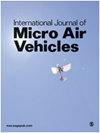A new nonlinear lifting line method for aerodynamic analysis and deep learning modeling of small unmanned aerial vehicles
IF 1.5
4区 工程技术
Q2 ENGINEERING, AEROSPACE
引用次数: 6
Abstract
In this work, a computationally efficient and high-precision nonlinear aerodynamic configuration analysis method is presented for both design optimization and mathematical modeling of small unmanned aerial vehicles. First, we have developed a novel nonlinear lifting line method which (a) provides very good match for the pre- and post-stall aerodynamic behavior in comparison to experiments and computationally intensive tools, (b) generates these results in order of magnitudes less time in comparison to computationally intensive methods such as computational fluid dynamics. This method is further extended to a complete configuration analysis tool that incorporates the effects of basic fuselage geometries. Moreover, a deep learning based surrogate model is developed using data generated by the new aerodynamic tool that can characterize the nonlinear aerodynamic performance of unmanned aerial vehicles. The major novel feature of this model is that it can predict the aerodynamic properties of unmanned aerial vehicle configurations by using only geometric parameters without the need for any special input data or pre-process phase as needed by other computational aerodynamic analysis tools. The obtained black-box function can calculate the performance of an unmanned aerial vehicle over a wide angle of attack range on the order of milliseconds, whereas computational fluid dynamics solutions take several days/weeks in a similar computational environment. The aerodynamic model predictions show an almost 1-1 coincidence with the numerical data even for configurations with different airfoils that are not used in model training. The developed model provides a highly capable aerodynamic solver for design optimization studies as demonstrated through an illustrative profile design example.基于非线性升力线的小型无人机气动分析与深度学习建模新方法
针对小型无人机的设计优化和数学建模,提出了一种计算效率高、精度高的非线性气动构型分析方法。首先,我们开发了一种新的非线性升力线方法,该方法(a)与实验和计算密集型工具相比,可以很好地匹配失速前和失速后的空气动力学行为;(b)与计算密集型方法(如计算流体动力学)相比,可以在更短的时间内生成这些结果。该方法进一步扩展为包含基本机身几何形状影响的完整结构分析工具。此外,利用新气动工具生成的数据,开发了基于深度学习的代理模型,可以表征无人机的非线性气动性能。该模型的主要新颖之处在于,它不需要像其他计算气动分析工具那样需要任何特殊的输入数据或预处理阶段,只需使用几何参数即可预测无人机构型的气动特性。所获得的黑箱函数可以在毫秒量级上计算出无人机在大攻角范围内的性能,而在类似的计算环境下,计算流体动力学的解决方案需要几天/几周的时间。空气动力学模型预测显示几乎1-1的巧合与数值数据,即使配置与不同的翼型,不用于模型训练。所建立的模型为设计优化研究提供了一个高性能的气动求解器,并通过一个外形设计实例进行了验证。
本文章由计算机程序翻译,如有差异,请以英文原文为准。
求助全文
约1分钟内获得全文
求助全文
来源期刊

International Journal of Micro Air Vehicles
ENGINEERING, AEROSPACE-
CiteScore
3.00
自引率
7.10%
发文量
13
审稿时长
>12 weeks
期刊介绍:
The role of the International Journal of Micro Air Vehicles is to provide the scientific and engineering community with a peer-reviewed open access journal dedicated to publishing high-quality technical articles summarizing both fundamental and applied research in the area of micro air vehicles.
 求助内容:
求助内容: 应助结果提醒方式:
应助结果提醒方式:


